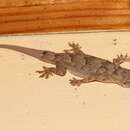en
names in breadcrumbs


Philippine lizards of the family Gekkonidae comprise 49 species (Taylor, 1915, 1922; Brown and Alcala, 1978) in 10 genera: Gehyra (1), Gekko (13), Hemidactylus (5), Hemiphyllodactylus (2), Lepidodactylus (6), Luperosaurus (8), Ptychozoon (1), Pseudogekko (4), and Cyrtodactylus (9), (Brown et al., 2007, 2010a, 2011; Welton et al., 2009, 2010a, 2010b; Zug, 2011). An amazing percentage of these species are endemic to the Philippines archipelago (roughly 85%; Brown et al., 2011). Several of the recently described gekkonids in the Philippines were discovered only recently as part of ongoing surveys around the archipelago. Recent phylogenetic studies focused on Philippine gekkonids (Siler et al., 2010; Welton et al., 2010a,b) have resulted in the observation of high levels of genetic diversity among populations of widespread species, an indication that the country's gecko diversity may still be greatly underestimated.
Two genera of "house" geckos are currently recognized to occur in the Philippines (Gehyra and Hemidactylus). Prior to the recent study by Mahony et al. (2009), Hemidactylus platyurus was recognized to be a member of the genus Cosymbotus; however, numerous studies over the years have indicated the species' close affinity to the genus Hemidactylus. One species of Gehyra (Gehyra mutilata) and five species of Hemidactylus (Hemidactylus brookii, Hemidactylus frenatus, Hemidactylus garnoti, Hemidactylus platyurus, Hemidactylus stejnegeri) are recognized to occur in the Philippines. Several species (Gehyra mutilata Hemidactylus Cosymbotus, and Hemidactylus franatus) are incredibly common and widespread across the archipelago, often being found in disturbed habitats and on the buildings and houses in residential areas. At night, large numbers of individuals of all three of these species can be observed preying on insects near light fixtures. No phylogenetic studies have investigated whether any of these widespread species represent unique lineages in the Philippines.
Dorsal tubercles numerous, large but not uniform in size, conical to rounded and keeled, in 14 to 18 uneven rows at midboy; seven to nine wide scansors (all but the terminal and basal one very deeply notched or divided) beneath the fourth toe; scansors covering the distal 3/4 to 4/5 of the toe; compressed, terminal phalanges of inner toe extending well beyond the dilated portion when depressed; five to eight pores in males covering the lateral part of the preanal region and the basal half of the ghigh on either side (10 to 16 in the combined series). (Text taken from Brown and Alcala, 1978)
This species has been reported from the islands of Mindanao, Bacoor, and Luzon in the Philippines.
In the Philippines, this species is currently associated with the Luzon and Mindanao Pleistocene Aggregate Island Complexes (PAIC; Brown and Diesmos, 2002).
49.5-63.6 mm SVL (Brown and Alcala, 1978)
restricted to Borneo (Smith, 1935; Brown and Alcala, 1978); syntypes stored in the British Museum; BMNH 1947.3.6.47-49 (syntypes)